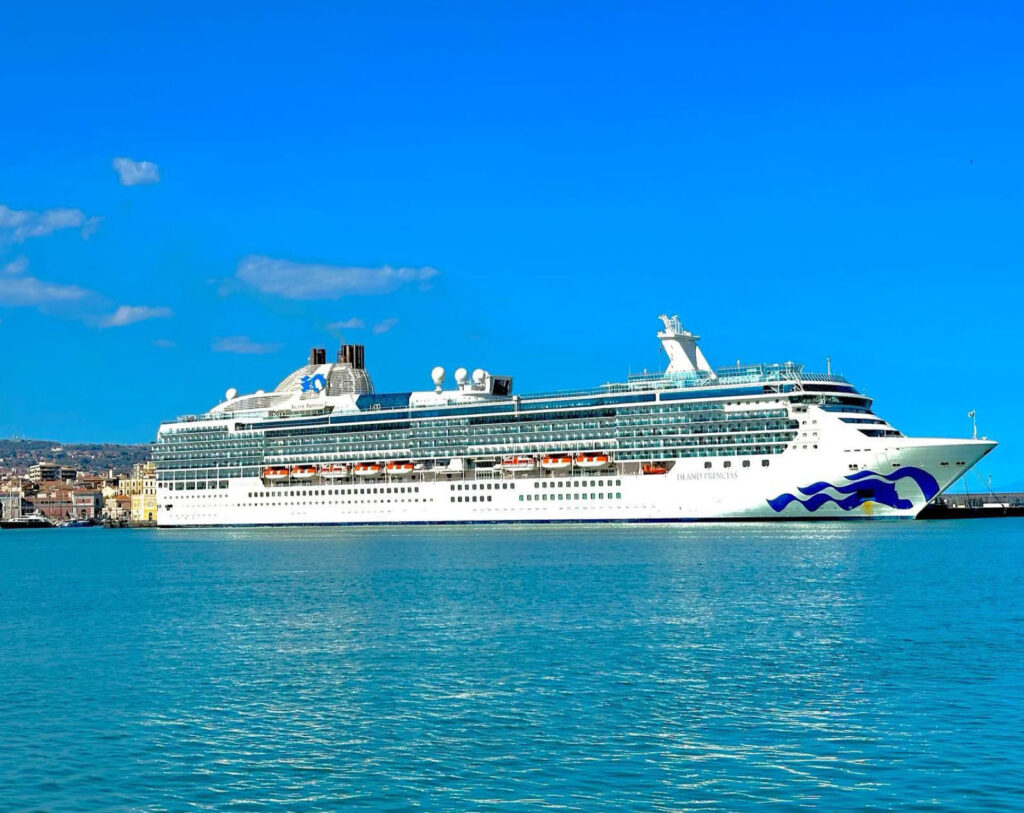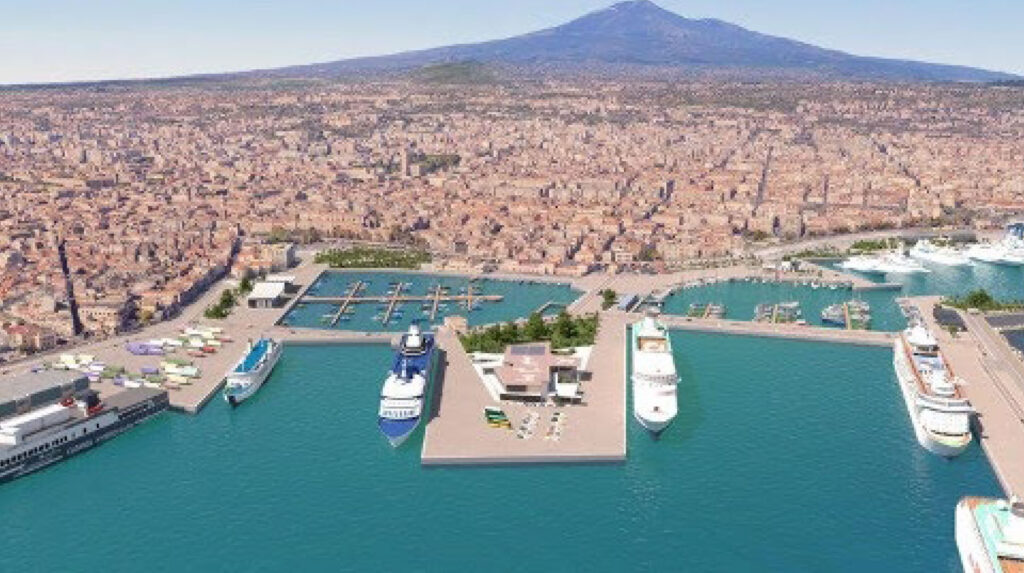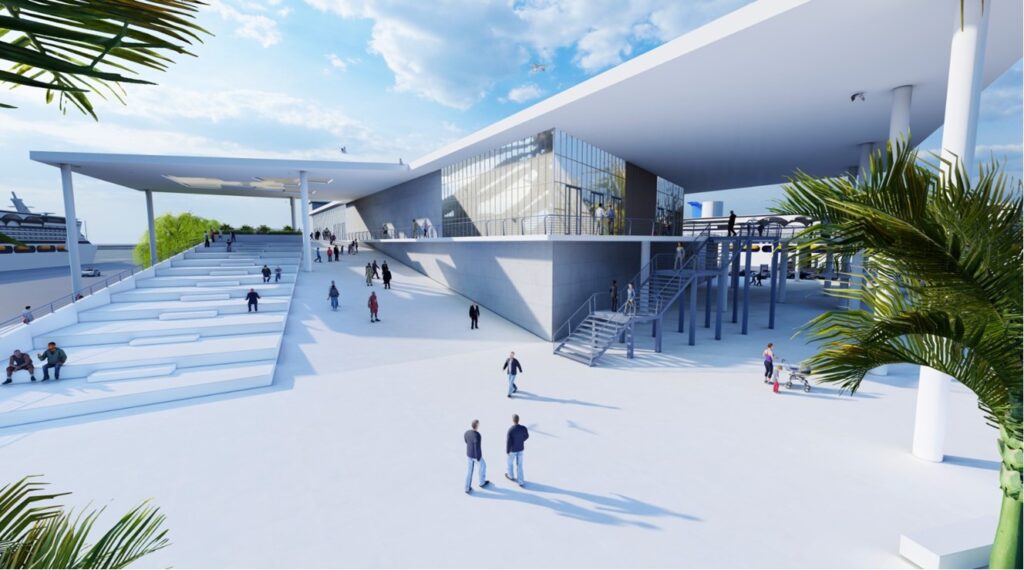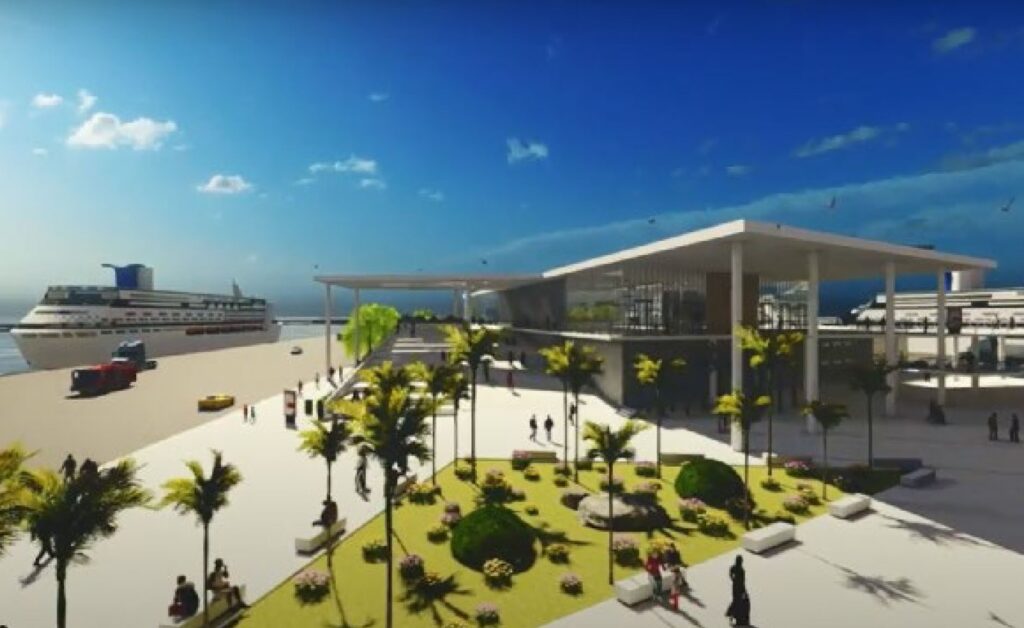╔
Destinazione Catania: le ricadute del turismo nautico e il ruolo della sostenibilità ambientale sul porto e sulla città
Catania ha un porto cittadino, a soli dieci minuti a piedi dal centro storico. Pur restando comunque un porto commerciale, la sua vocazione turistica già da tempo attrae una grossa fetta di turismo crocieristico e di diporto nautico.
La città, dominata dal vulcano Etna che la rende, al pari del resto della Sicilia orientale, calda e spumeggiante come le sue viscere, costituisce da sempre un polo di attrazione mondiale grazie al suo ricco patrimonio monumentale, paesaggistico ed enogastronomico.
Svariate sono quindi le offerte delle escursioni per il popolo di crocieristi e diportisti, che oltre alle sempre ambite, ma già estremamente conosciute, Catania, Siracusa, Taormina ed Etna, possono spaziare tra molteplici percorsi naturalistici a piedi o in bici fruibili tutto l’anno; spiagge dorate e acque limpide; itinerari enogastronomici, in cui esplorare le diverse sfumature e i sentori dei vini siciliani esportati nel mondo, abbinati alla tradizione della cucina locale; corsi di slow food e altre proposte di sicuro interesse.
La centralità dello scalo etneo rispetto alle principali mete turistiche della Sicilia orientale, per la maggior parte raggiungibili in circa un’ora di percorrenza, assicura al porto di Catania la presenza di grandi flussi turistici. Inoltre, la vicinanza del terminal crociere al centro storico permette al crocierista di visitarlo agevolmente e godere degli elementi che lo caratterizzano: arte, storia, folclore, gusto e tradizione.
Catania has a city port, just a ten-minute walk from the historic center. Although it remains a commercial port, its tourist vocation has long attracted a large portion of cruise and pleasure yachting tourism.
The city, dominated by the Etna volcano, which makes it and the whole eastern Sicily as hot and bubbly as its bowels, has always been a worldwide major attraction thanks to its rich monumental, landscape and food and wine heritage.
For this reason, the shore excursion offer for cruise passengers and pleasure yachting tourists is wide. In addition to the always sought after, but already extremely well-known, Catania, Syracuse, Taormina and Etna, people can choose between multiple nature trails on foot or by bike that can be enjoyed all year round; golden beaches and clear waters; food and wine itineraries, in which to explore the different nuances and aromas of Sicilian wines exported worldwide, combined with the tradition of local cuisine; slow food courses and other interesting proposals.
The centrality of the Etna port with respect to the main tourist destinations of Eastern Sicily, mostly reachable in about one hour’s journey, ensures the presence of large tourist flows in the port of Catania. Furthermore, the proximity of the port to the historic center allows nautical tourists to visit it easily on foot.
Il turismo portuale
Port Tourism
Il turismo legato al mare, sia esso da diporto, crocieristico o balneare, permette di destagionalizzare il comparto e far vivere il porto e la città 12 mesi l’anno.
Il turismo portuale è un’importante risorsa economica per la città di Catania, in quanto il porto rappresenta una fondamentale porta d’ingresso via mare per i turisti che decidono di visitarla e scoprire le sue meraviglie.
Inoltre, il turismo portuale ha un impatto positivo anche sullo sviluppo infrastrutturale catanese, creando la necessità di potenziare e ammodernare le strutture portuali e della città per accogliere un numero sempre crescente di crocieristi e passeggeri di traghetti e maga yacht. Fosse anche solo per il cospicuo numero di crocieristi in transito che arrivano su grosse navi da crociera, la ricaduta economica sul territorio è decisamente rilevante. Oltre all’indotto diretto generato dai passeggeri che sbarcano e decidono di trascorrere del tempo in città, vi è un indotto indiretto che coinvolge le attività commerciali e di servizio presenti nella zona portuale e all’interno del terminal passeggeri.
Numerosi ristoranti, bar, negozi, agenzie e guide turistiche beneficiano dell’afflusso di turisti che arrivano via mare, offrendo loro tour, prodotti e servizi tipici del territorio.
In conclusione, il turismo portuale rappresenta un importante volano economico per il comprensorio catanese, favorendo crescita e sviluppo grazie alla capacità di attrarre visitatori da ogni Paese e valorizzare le risorse locali. È fondamentale, quindi, investire nella promozione e nello sviluppo di questo settore, al fine di sfruttarne appieno il potenziale e far brillare sempre di più la città etnea nel panorama internazionale.
Tourism linked to the sea, be it recreational, cruise or seaside, allows the sector to be deseasonalised and the port and city to host people 12 months a year.
Sea tourism is an important economic resource for the city of Catania, as the port represents a fundamental gateway for tourists who decide to visit it and discover its wonders arriving by cruise ships, ferries, or yachts.
Furthermore, cruise tourism has a positive impact on the infrastructural development of the areas, creating the need to strengthen and modernize port and city’s facilities to accommodate an ever-increasing number of cruise passengers. The high number of people in transit disembarking from large cruise ships, has a significant economic impact on the Etna port, the city and its surroundings. In addition, cruise tourism also generates incomes to all commercial and service activities in the port and inside the passenger terminal.
Numerous restaurants, coffee shops, souvenirs shops, agencies and tourist guides benefit from people arriving by sea, offering them tours and typical local products and services.
In conclusion, port tourism represents an important economic driver for the port and city areas, promoting growth and development, thanks to the ability to attract visitors from every Country, and enhancing local resources. It is essential, therefore, to invest in the promotion and development of this sector, to fully exploit its potential and make the Etna city shine more and more on the international scene.
Catania, destinazione turistica tutto l’anno
Catania, an All-Year-Round Destination
Il porto di Catania, grazie alla sua prossimità al centro storico della città, è uno dei principali scali marittimi del Mediterraneo e ogni anno accoglie migliaia di passeggeri. Grazie alla sua posizione strategica, a pochi chilometri dall’aeroporto internazionale di Fontanarossa, il porto accoglie ogni anno crocieristi che arrivano in aereo e si imbarcano e sbarcano a Catania per iniziare e finire la loro crociera nella nostra città, creando quindi un flusso di operazioni di homeporting e conferendo allo scalo crocieristico di Catania la possibilità di crescere sempre più come hub di rilevo per le crociere nel Mediterraneo.
The port of Catania is one of the main seaports in the Mediterranean and every year it welcomes thousands of passengers. Thanks to its strategic proximity to the international airport “Vincenzo Bellini”, the port, apart from cruisers in transit, also welcomes passengers arriving by plane and embarking and disembarking in Catania to start and end their cruise, thus creating a flow of homeporting operations and giving the port the possibility of growing more and more as a major hub for cruises in the Mediterranean.

Nave da crociera nel porto di Catania. (© Autorità di Sistema Portuale del Mare di Sicilia Orientale).
A cruise ship in the port of Catania. (© Port System Authority of the Eastern Sicilian Sea).
Costa Crociere ha scelto, già dal 2021, lo scalo etneo per le sue importanti operazioni di interporting con una movimentazione, nel 2023, di circa 1800/1900 passeggeri in imbarco e sbarco per ogni approdo. Inoltre, sempre nel 2023, Costa ha organizzato charter aerei settimanali che dalla Spagna portavano i passeggeri a Catania, punto di imbarco per iniziare la crociera. Questa attività potrebbe diventare preludio di una visione più ampia sulla gestione dei flussi crocieristici in imbarco provenienti da charter organizzati dalle Cruise Line. Il tutto gestito con una fattiva collaborazione fra Autorità di Sistema Portuale, Aeroporto e Terminal Crociere.
La stagione crocieristica 2023 ha visto a Catania, fra navi grandi e piccole, un incremento di passeggeri dai 154.000 del 2022 ai circa 236.500 del 2023: un flusso turistico importante non solo per la città, ma per tutto il “Sud – Est” della Sicilia, grazie al lavoro che i crocieristi garantiscono all’indotto del comparto. Il 2023 ha visto toccate nave da parte di compagnie quali Costa Crociere con ben 31 approdi e solo per citarne alcune altre, Aida, TUI, Azamara, Celebrity, Club Med, Croisi Europe, Fred Olsen, Noble Caledonia e tante altre. Nel 2023 si è assistito anche a 5 overnight, 6 doppi approdi e 19 maiden call.
Una forte leva per l’incentivazione dei viaggi in mare è la conoscenza fra i giovani del settore della portualità. Alcune università, come ad esempio quella di Hannover, Anversa e Amburgo, hanno da anni Dipartimenti di Economia Marittima.
Il porto dispone attualmente di tre banchine prioritariamente dedicate all’accosto delle navi da crociera e un terminal per l’accoglienza passeggeri.
Catania, oltre ad ospitare le grandi navi è anche meta scelta da un turismo croceristico di nicchia, il cosiddetto segmento “luxury”: si tratta di navi piccole, con una capacità massima di 1000 passeggeri. Il turista di lusso viaggia tutto l’anno, destagionalizzando quindi il mercato delle crociere, a volte scegliendo una Cruise Line già conosciuta, ma mete diverse a seconda della stagione.
Tra gli elementi principali e caratteristici di questo settore troviamo:
- Le “esperienze esclusive” (in tutti i comparti turistici e per tutti i servizi)
- Le “modalità sostenibili” (c.d. turismo green)
- La “ricerca di emotività” (emozioni e spiritualità)
La Sicilia è una fra le destinazioni più gettonate per turismo croceristico di lusso internazionale e il turista “luxury” appartiene ad una fascia alto-spendente; quindi, questo nicchia rappresenta un driver economico molto importante.
Inoltre, anche le strutture alberghiere e ricettive cittadine registrano un aumento delle prenotazioni prima e successivamente all’arrivo di una nave da crociera. Una ricerca di CLIA (Cruise Line International Association) ha dimostrato che 6 crocieristi su 10, se favorevolmente colpiti dalla meta e dai servizi del territorio ritornano almeno una volta non più via mare, ma via terra o via aria con un soggiorno medio di tre giorni.
Nell’ottica di un sempre più ampio sviluppo del traffico crocieristico e dell’importante rapporto porto-città, una particolare attenzione verrà dedicata, con il nuovo Piano Regolatore Portuale (PRP), allo sviluppo del “waterfront” che comporterà anche la realizzazione di un nuovo terminal passeggeri, da asservirsi al traffico crocieristico e Ro-Pax, in grado di offrire servizi ed eccellenza nell’ambito dell’accoglienza.
Costa Crociere has chosen, as early as 2021, the Etna port for its important interporting operations with a movement, in 2023, of approximately 1800/1900 passengers embarking and disembarking for each call. Furthermore, Costa organized air charters that took passengers from Spain to Catania where they embarked to start their cruise, an activity that could become, through an active cooperation among the Port System Authority, the Airport and the Cruise Terminal, a prelude to a broader vision on the management of cruise flows generated from charters organized by Cruise Lines.
The 2023 Catania cruise season saw an increase in passengers of both big and small ships, from 154,000 in 2022 to around 236,500 in 2023: an important tourist flow not only for the city, but also for the entire southeastern district. Costa Crociere chose Catania with its 31 calls, but we also saw Aida, TUI, Azamara, Celebrity, Club Med, Croisi Europe, Fred Olsen, Noble Caledonia and many others. The 2023 season also view 5 overnights, 6 double calls and 19 maiden calls.
Knowledge among young people of the port sector is very important for encouraging sea travel. Some universities, such as those of Hanover, Antwerp and Hamburg, have had departments of Maritime Economics for years.
The port currently has three quays primarily dedicated to the docking of cruise ships and a passenger terminal.
Catania, in addition to hosting large ships, is also a destination chosen by niche cruise tourism, the so-called “luxury” segment: these are small ships, with a maximum capacity of 1000 passengers. Luxury tourists travel all year round, therefore deseasonalizing the cruise market, sometimes choosing an already known Cruise Line, but different destinations depending on the season.
Among the main and characteristic elements of this sector we find:
- “Exclusive experiences” (in all tourist fields and for all services)
- “Sustainable modalities” (the so-called green tourism)
- “Search for emotionality” (emotions and spirituality)
Sicily is one of the most popular destinations for international luxury cruise tourism. Considering that the “luxury” tourist belongs to a high-spending segment, this niche represents a very important economic driver.
Furthermore, city hotel and accommodation facilities also record an increase in bookings before and after the arrival of a cruise ship. Research by CLIA (Cruise Line International Association) has shown that 6 out of 10 cruise passengers, if favorably impressed by the destination and the local services, return at least once no longer by sea, but by land or by air with an average stay of three days.
With a view to an increasingly broad development of cruise traffic and to the important port-city relationship, particular attention will be dedicated, with the new Port Regulatory Plan (PRP), to the development of the “waterfront” which will also involve the construction of a new passenger terminal, to serve cruise and Ro-Pax traffic, capable of offering high-level services and excellence in hospitality.
Navigando verso nuove avventure: lo sviluppo del turismo da diporto al Porto di Catania
Heading Towards New Adventures: The Development of Pleasure Yachting in the Port of Catania
Il turismo da diporto ha guadagnato molta popolarità negli ultimi anni, con sempre più appassionati che cercano esperienze autentiche e avventure uniche in mare aperto e a terra nelle destinazioni raggiunte. In questo contesto, il Porto di Catania si presenta come una meta ideale per gli amanti del mare e della navigazione, offrendo una combinazione di storia e bellezze naturalistiche tali da renderlo potenzialmente un punto di riferimento nel panorama del turismo da diporto. Restano invece ancora penalizzati i servizi dedicati alla nautica da diporto (pontili per l’attracco di yacht, mega yacht e barche a vela e, in parte, anche la cantieristica).
Ad oggi quindi, il settore della nautica da diporto a Catania non ha ancora raggiunto livelli di sviluppo tali da incidere sostanzialmente sull’economia portuale e cittadina. Tuttavia, come vedremo nel paragrafo successivo, il nuovo Piano Regolatore Portuale che entrerà in vigore entro il 2024, prevede una notevole crescita delle strutture e del numero di banchine riservate alle navi da crociera ai traghetti passeggeri e agli yacht in generale.
Pleasure yachting has gained much popularity in recent years, with more and more people looking for authentic experiences and unique adventures in the open sea and during shore excursions. In this context, the Port of Catania is an ideal destination for lovers of the sea and sailing, offering a combination of history and natural beauty such as to potentially make it a point of reference in the panorama of pleasure yachting. However, services dedicated to pleasure boating are still penalized (lack of piers for mooring yachts and mega yachts and, in part, also lack of shipbuilding suitable spaces).
So, to date, the pleasure boating sector in Catania has not yet reached developmental levels capable of substantially impacting the port and city economy. However, as we will see in the next paragraph, the new Port Regulatory Plan which will come into force by 2024, provides for a notable growth in the structures and number of quays reserved for cruise ships, passenger ferries, yachts and nautical tourism in general.
Il turismo crocieristico e da diporto secondo il nuovo Piano Regolatore Portuale
Cruise and Pleasure Yachting According to the New Port Regulatory Plan
Relativamente alla parte del porto dedicata al turismo, il nuovo PRP la vede in futuro aperta ai cittadini, green e smart. Ovviamente questo risultato avrà bisogno di alcuni anni per essere raggiunto e per poterne fruire a pieno.
In un futuro a medio termine, l’area crociere sarà di 84mila mq con quattro accosti in grado di accogliere navi da oltre 340 m e sullo sporgente centrale la nuova stazione marittima di 5mila mq, dall’architettura particolarmente originale, potrà accogliere 1 milione di passeggeri l’anno, con sistemi di energie rinnovabili in grado di renderla autosufficiente dal punto di vista energetico. Si stima che nel 2040 sbracheranno tra i 490mila e gli 848mila tra crocieristi e passeggeri.
Regarding the port areas dedicated to tourism, the new PRP see them open to citizens, green and smart. Obviously, this result will take a few years to be achieved and to allow people to fully benefit from it.
In a medium-term future, the cruise area will measure 84,000 square meters with four quays capable of accommodating ships of over 340-meter length. On the “Sporgente Centrale” pier, the new 5,000 square meter maritime station, with its particularly original architecture, will be able to accommodate one million passengers a year, with renewable energy systems, capable of making it self-sufficient from an energy point of view. It is estimated that in 2040 the port will host between 490,000 and 848,000 cruisers ferry and yacht passengers.

Rendering dell’area riservata agli accosti turistici secondo il nuovo Piano Regolatore Portuale di Catania. (© Autorità di Sistema Portuale del Mare di Sicilia Orientale).
Rendering of the tourist area according to the new Port Regulatory Plan of Catania. (© Port System Authority of the Eastern Sicilian Sea).
Il waterfront, con una suggestiva passeggiata sul mare, si svilupperà dal nuovo porticciolo per yacht, nelle immediate vicinanze della stazione ferroviaria, fino al porto Nuovo e al molo Crispi: 17 ettari circa che diventeranno un quartiere cittadino arredato con manufatti architettonici scenografici e innovativi, un gateway porto-città per fruire del centro storico e del porto. La “Darsena yacht”, con una viabilità dedicata e un accesso diretto al mare aperto, ospiterà oltre 700 imbarcazioni da diporto di piccole (4/18 mt), medie (18/28 mt) e grandi dimensioni (fino a 120 mt), creando di fatto un ampio mercato della cantieristica (oggi compromessa per mancanza di spazi idonei nella zona sud ovest del porto e nel Piazzale Triangolare).
The waterfront, with its beautiful promenade on the sea, will be developed on an area going from the new yachting marina, near to the railway station, up to the Porto Nuovo and the Crispi pier: approximately seventeen hectares which will become a city district with scenographic and innovative architectural artefacts, a port-city gateway to enjoy, at the same time, the historic center and the port. The “Darsena yacht”, with a dedicated road network and direct access to the open sea, will host over 700 small (4/18 meters), medium (18/28 meters) and large (up to 120 meters) pleasure boats, thus creating a large shipbuilding market.
Rendering del futuro terminal passeggeri al porto di Catania. (© Autorità di Sistema Portuale del Mare di Sicilia Orientale).
Rendering of the future passenger terminal in the port of Catania. (© Port System Authority of the Eastern Sicilian Sea).


Rendering delle aree verdi nel futuro terminal passeggeri. (© Autorità di Sistema Portuale del Mare di Sicilia Orientale).
Rendering of green areas in the future Catania passenger terminal. (© Port System Authority of the Eastern Sicilian Sea).
Verso un porto green: la sostenibilità energetica a Catania
Catania Towards a Green Port: Energy Sustainability
L’elettrificazione a terra (shore power) è una tecnologia che offre un grande potenziale per ridurre le emissioni di gas serra delle navi da crociera: consente alle navi di spegnere i motori diesel durante l’ormeggio, riducendo così le emissioni di ossido di azoto, ossidi di zolfo e particolato.
Al momento, nel mondo, solo il 2% dei porti è attrezzato per fornire energia elettrica alle navi attraccate, ma a essere predisposto è già il 46% delle navi da crociera e un altro 30% può essere riadattato.
Relativamente all’utilizzo delle tecnologie shore to ship, il porto di Catania, grazie ai risultati di uno studio condotto dal Dipartimento di Ingegneria Civile e Architettura dell’Università di Catania sui traffici navali, per le navi da crociera sta implementando un sistema di shore power tramite un mezzo mobile che trasporterà il cavo in una delle tre “junction box” presenti lungo le banchine.
I lavori inizieranno entro giugno 2024 e si concluderanno entro giugno 2026, in quanto finanziati con fondi PNRR. La potenza richiesta è di 47 MW e l’importo finanziato è di 56,5 milioni di euro.
L’aspetto positivo principale derivante dalla costruzione dell’impianto di cold ironing sarà la riduzione delle emissioni inquinanti in atmosfera e delle vibrazioni prodotte dai motori a combustione interna che mettono in rotazione i generatori ausiliari. Tutto questo consentirà una positiva ricaduta ambientale, con il raggiungimento di importanti benefici per l’ambiente urbano e la salute umana.
Onshore electrification (shore power) is a technology that offers great potential to reduce greenhouse gas emissions from cruise ships and ferries: it allows ships to turn off their diesel engines while at berth, thus reducing nitrogen oxide, sulfur oxides and particulates emissions.
At present, worldwide only 2% of ports are equipped to supply electricity to docked ships, but 46% of cruise ships are already equipped for shore power and another 30% can be re-adapted.
Regarding the use of shore to ship technologies, the port of Catania, thanks to the results of a study led by the Department of Civil Engineering and Architecture of the University of Catania on naval traffic, is going to implement a shore power system for cruise ships via a mobile tool that will transport the cable to one of the three “junction boxes” along the docks.
The works will begin by June 2024 and will be completed by June 2026, as they are financed with National Recovery and Resilience Plan funds. The power requested is 47 MW and the amount financed is 56.5 million euros.
The main positive aspect deriving from the construction of a shore power system will be the reduction of polluting emissions into the atmosphere and of vibrations produced by the internal combustion engines that activate rotation of the auxiliary generators.
IMMAGINE INIZIALE | Vista panoramica del Porto di Catania. (© Autorità di Sistema Portuale del Mare di Sicilia Orientale).
HEAD IMAGE | Panoramic view of the Port of Catania. (© Port System Authority of the Eastern Sicilian Sea).
╝
RIFERIMENTI
REFERENCES
State of The Cruise Industry Outlook 2022, Cruise Line International Association online publication.